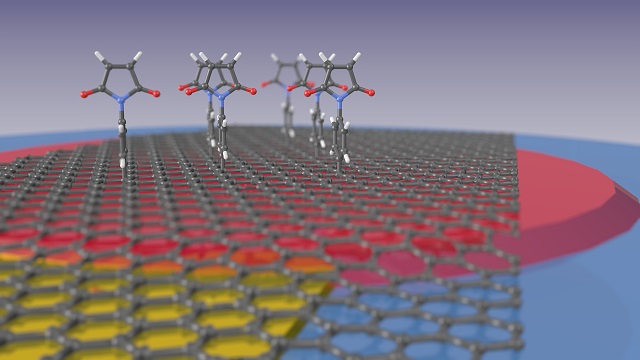 The illustration shows how maleimide compounds bind to the graphene surface. The graphene monolayer lies on a thin film of silicon nitride (red) that in turn is on a quartz microbalance (blue) and can be subjected to a potential via a gold contact (yellow). Credit Illustration: Marc Gluba/HZB
The illustration shows how maleimide compounds bind to the graphene surface. The graphene monolayer lies on a thin film of silicon nitride (red) that in turn is on a quartz microbalance (blue) and can be subjected to a potential via a gold contact (yellow). Credit Illustration: Marc Gluba/HZB
Researchers from the HZB Institute for Silicon Photovoltaics have succeeded in accurately determining and controlling the thickness of an organic compound, which has been attached to a graphene layer. This could enable graphene to be used as a sensitive detector for biological molecules.
Pure carbon exists in several forms. Graphite, diamond and coal are the natural forms of pure carbon. Graphene is form of pure carbon consisting of a single atomic layer thick structure similar to a honeycomb, which is a hexagonal mesh comprising a carbon atom at each corner. This means graphene is basically a two-dimensional structure. Therefore, it is completely transparent, highly conductive, and highly resilient both mechanically and chemically.
Graphene is Not Very Selective
It is an accepted fact that graphene is suited to detecting organic molecule traces. This is because graphene's electrical conductivity drops as soon as foreign molecules attach to it. The issue is that this happens with almost every molecule. Since graphene is not selective, differentiating molecules becomes very difficult. Hence using it as a sensor is not possible.
Mounting Brackets for Detector Molecules Attached
The researchers have devised a technique to improve the selectivity of graphene. They were able to electrochemically activate graphene and prepare it to host molecules, which behave as selective binding sites. Para-maleimidophenyl groups from an organic solution were attached to the graphene surface in order to achieve this. These organic molecules act as mounting brackets to which selective detector molecules can be bonded in the subsequent step.
Thanks to these molecules, the graphene can now be employed for detecting various substances similar to how a key fits a lock. These surface lock molecules are very selective and absorb just the matching key molecules.
Dr. Marc Gluba
Large Graphene Surfaces at HZB
Similar types of experiments were also carried out along the same lines by other research groups. However, they had only very small graphene flakes with diameters in microns so that there was a predominance of edge effects. Chemists and physicists produced graphene surfaces of size of several square centimetres so that edge effects do not play any role when compared to the surface processes. The graphene layer was then shifted to a quartz crystal microbalance. The quartz crystal's oscillatory frequency changes in response to any mass increase, thereby enabling to measure amounts as small as individual molecular layers.
Precise Detection and Control
For the first time, we were able to precisely and accurately detect how many molecules actually were grafted to the surface of the graphene.
junior researcher Felix Rosicke
In addition, we can precisely control how many molecules bind to the graphene by adjusting an applied voltage.
Dr. Jorg Rappich from the HZB Institute for Silicon Photovoltaics, Rosicke's advisor.
"The hopes we have for graphene are really enormous" says Prof. Norbert Nickel, head of the research team. One example is the possibility of fabricating a low-cost "lab-on-a-chip" that requires only a single drop of blood to deliver meaningful data immediately for key medical diagnostics.
References